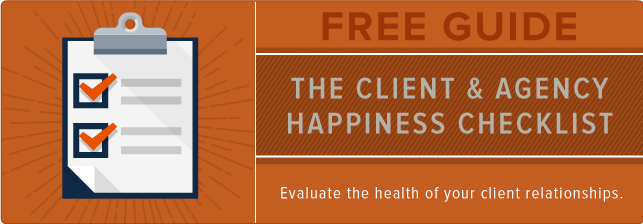
27 Sep 10 Common Phrases You Should Stop Using in Client Emails Immediately
[ad_1]

Think your email skills are strong? Think again. As it turns out, we all overestimate our ability communicate effectively over email.
In a study published in the Journal Of Personality And Social Psychology, email writers thought readers would correctly identify the tone of their emails about 78% of the time. In reality? Only 56% of emails were interpreted accurately.
That means when you send an email off to a client, there’s a pretty good chance they won’t fully grasp your intended meaning.

So how can you proof your emails to avoid problematic misunderstandings with your clients? Start by cutting the fat. The following commonly used phrases are unnecessary, cliché, and easy to misinterpret. Eliminate them from your email repertoire to take your client communications to the next level.
10 Common Phrases to Stop Using in Client Emails
1) “Sorry to bother you”
You might say this when you want to sound polite and considerate of your client’s busy schedule, but opening an email with an apology immediately undermines your credibility.
It’s in your client’s best interest to cooperate with the agency or freelancer they hired, so there’s no need to apologize for sending them a legitimate business email that helps advance their project.
Instead of apologizing, get straight to the point: Why are you really contacting your client, and what do you need from them? They’ll appreciate your candor.
2) “Let’s touch base”
This phrase has the not-so-honorable distinction of being one of the most overused corporate phrases ever, and unless you’re literally talking about landing a helicopter, there’s no need to use it in your client emails.
The biggest issue with asking a client to “touch base” is that it’s too vague. It’s a filler phrase that doesn’t explain to your client what you want to discuss, leaving them completely in the dark.
Swap it out for something actionable that lets the client know what their next steps should be, e.g., “Let’s meet on Friday to discuss the latest website edits.”
3) “To be honest with you … “
This one is tricky. It’s commonly used to add emphasis to a candid remark or soften the blow of a blunt comment (“To be honest with you, that red marquee banner is aggressive”), but it could have the exact opposite effect, leaving your client wondering, “Wait … were you not being honest with me before?”
This seemingly innocuous phrase can make it seem like you’ve been hiding your true opinions this whole time, which obviously isn’t great for building trust. The client hired you for your expertise, so they expect you to share your true opinions openly and honestly, not just in select situations.
Cut this phrase from your emails and instead focus on telling it like it is — without any crutch phrases.
4) “You should … “
When you’re on the 4,267th revision of a project, and your client is insistent that pink Comic Sans font is the way to go, it can be challenging to refrain from typing back, “You should really just use X font instead.”
Yes, your client did hire you to give them advice, but they didn’t hire you to make all their decisions for them. While starting a sentence with “you should” might sound fine in person, it could easily be misinterpreted as pushy or dismissive over email.
Use “I recommend … ” instead — it will make sure your remarks are read as friendly advice. Offer your client alternatives, not ultimatums.
5) “No problem”
Customer service experts and business writers agree: “No problem” can be a big problem. This ostensibly polite phrase is usually a knee-jerk reaction to “Thank you,” but it can subtly communicate to your client that whenever you do something for them, it actually is a problem. “No problem” sounds like you’re forgiving your client for an offense, rather than accepting their thanks.
Are we overthinking this? Maybe. Should you still cut it from your emails? Definitely. It’s easy enough to replace with a “You’re welcome,” or “Sure thing,” rather than risk the miscommunication.
6) “I’ll try … “
In a world ruled by deadlines and calendar invites, “I’ll try” sounds wishy-washy. If you respond to a client’s request with “I’ll try to get that done by Wednesday,” or “I’ll try to redo the color scheme,” you aren’t exactly instilling confidence in your ability to get the work done. Even worse, it can make the client see you as disengaged or not fully committed to their project.
When communicating over email without the aid of body language and tone, it’s important to convey information in precise, detailed terms. Even if you’re legitimately unsure about when you’ll be able to get something done, provide the client with a real deadline — just push it out far enough to give yourself adequate time. Be clear about your timeline and priorities with the client.
7) “The problem is … “
Issues will inevitably arise on client projects. It’s how you frame them that really matters.
Instead of framing a problem as well, a problem, try to explain it is a specific challenge with a known solution. The additional information will help assure the client that you know exactly what’s wrong, and more importantly, how to fix it.
“The problem is your website navigation is broken,” sounds alarming and vague, but “We’re working on fixing some coding issues with your website navigation” sounds like you have a handle on what’s happening.
8) “I completely understand how you feel”
Before you write this in an email, stop and think: Have you ever been in this exact situation before? No? Then don’t write this phrase. It will only frustrate an already-frustrated client.
“I understand how you feel” might seem like a thoughtful, well-intentioned thing to write to a client experiencing project roadblocks, but it can come across as distanced and condescending in an email.
There’s almost always a better, more specific way to level with a client when things aren’t going as planned. Try: “I can definitely see how this is frustrating for you, and I want to make sure we’re addressing it ASAP.” Action-oriented language will console a client more than vague apologies.
9) “As I mentioned before … “
Even though it might seem like you’re always explaining the same things over and over again to your clients, it’s important to avoid this morale-killing phrase. The average person receives 122 emails per day, so you’ll have to forgive them if they occasionally skim through or miss some of your communications.
Instead of drawing attention to the fact that you’re repeating yourself (as satisfying as that might seem) try to be considerate of the fact that — like you — your client is busy, and sometimes details slip through the cracks. If a client is consistently missing the point, it’s probably time for a face-to-face meeting or a call. Not everything can be solved over email.
10) “Let me know if there’s anything else I can do for you”
This phrase can be an unexpected coup de grâce for your inbox, inviting a bombardment of requests and tweaks from your client — some of which might even fall out of the project’s scope.
Asking if you can help your client with anything else seems like a perfectly harmless way to close an email, but it can actually signal that you’re willing to accommodate each and every request that arises. Instead of opening the door for any and all new requests, be precise: “Let me know if you have specific questions about the new website navigation.”
What phrases do you avoid using in client emails? Let us know in the comments.
[ad_2]
Source link
Social Media Agency, Social Media, Digital Marketing, Digital Marketing Agency, Search Engine Marketing, SEO, digital marketing agency dubai, video content marketing, crossfit marketing dubai, video marketing dubai, digital marketing agency abu dhabi, facebook marketing dubai, facebook marketing abu dhabi, digital marketing agencies in dubai, social media agency, content marketing dubai, content strategy dubai, branding dubai


